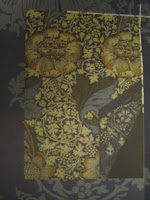
I saw this Whitworth Art Gallery Touring Exhibition at the Brighton Museum and Art Gallery. The part about the history of indigo dying was interesting and there were some lovely pieces of work illustrating the different uses of indigo.
I was most interested in the modern pieces, particularly the installation by Hiroyuki Shindo. It was made up of eight panels each comprising three parts: the central one in each hanging was patterned and the outer ones were plain, several of the outer pieces were see through. This made the piece seem lighter than I was expecting because the eight panels wafted slightly in the breeze. The sections of the panels were loosely joined by open stitching, which also enhanced their lightness. The installation was hung with four panels on each side and dyed indigo balls of string were placed on the floor in the central area. I thought this worked well because it tied the whole piece together and made it an installation rather than eight separate hangings. Unfortunately photography was not allowed.
















